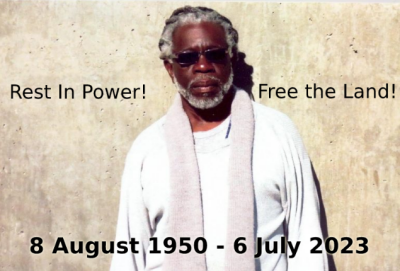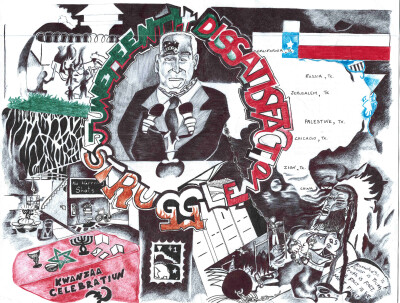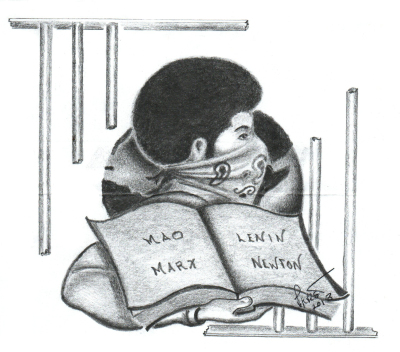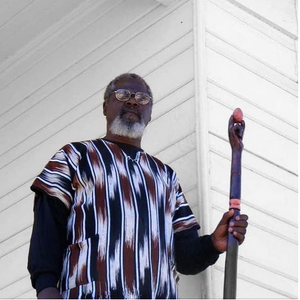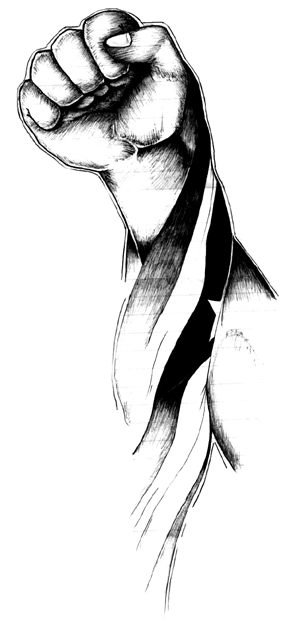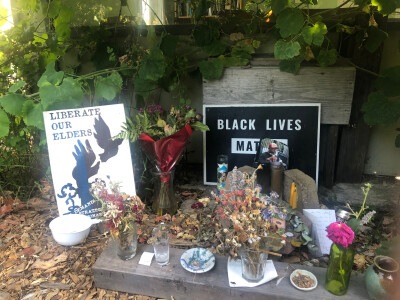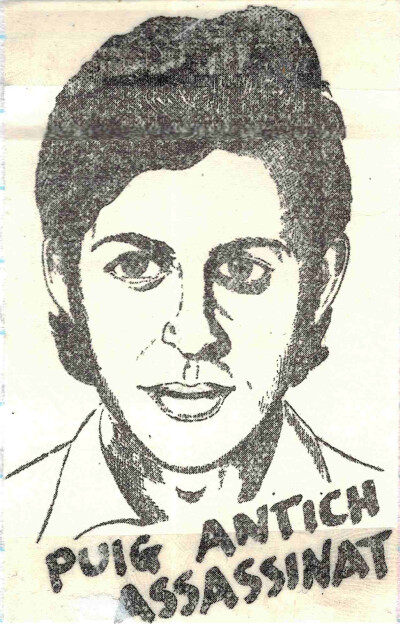As the assassination date of our redeemed comrade Stanley Tookie
Williams Sr. approaches (December 13th), this will mark 17 years that
our beloved brother, comrade, and C.R.I.P co-founder Stanley Tookie
Williams Sr. was deliberately assassinated by the U.$. imperialist’s
“Correctional Institute (Colony) Repressive Penal System.” It is our
esteemed comrade Stanley “Big Tookie” Williams Sr. along with comrade
Raymond Washington who founded the C.R.I.P.s in 1969. Stanley Big Tookie
Williams ran the West Side Cribs (“Cribs” eventually became “CRIPS” by
1971) and comrade Raymond Washington ran the East Side CRIPS. There was
a small neighborhood community after school center on the East Side of
Los Angeles, California where comrade Raymond Washington and his friends
hung out after school playing pool called the “Community Resource Inner
City Project Service” (C.R.I.P.S).
From this Community Resource Inner City Project Service the “CRIPS”
would form into a bastard party of the former remnants of the Black
Panther Party (a community based nationwide Black nationalist
organization who operated free breakfast programs in the poor
disenfranchised sections of the ghettos and Brown barrios and promoted
“self defense” against U.$. terrorist government sanctioned racial
violence).
Originally when Raymond Washington and Big Tookie Williams joined up
the East Side and West Side CRIPS were about protecting their
communities against other “white” gangs who came into Black
neighborhoods to start trouble and violence against Black people in
general. The C.R.I.P.S. (Community Revolutionary Inter-Party Soldiers)
promoted Community Revolution in Progress (C.R.I.P.) yet over the years
ended up becoming a “self destructive” force which ended up being
consumed by Black self-hatred and non-political violence.
Eventually Comrade Raymond Washington was murdered in the streets of
East Side South Central Los Angeles. He was assassinated by a car of
unknown assailants, in 1979. Comrade Stanley “Big Tookie” Williams was
wrongfully framed by the U.$. government on gruesome murder charges that
he did not commit (and in which he maintained his innocence up until his
dying day). Big Tookie was falsely convicted by a racist court system
and jury which ended up landing him on California’s Death Row at San
Quentin State Prison in the early 1980’s.
Ten years prior to Stanley “Big Tookie” Williams’ arrival, San
Quentin State Prison was the assassination scene of the bold, brilliant
and beautifully courageous revolutionary activist, author and
revolutionary theoretician Comrade George Lester Jackson on 21 August
1971. Jackson was moved to the Adjustment Center in San Quentin on
murder charges of killing a Soledad correctional officer. 25 year old
Officer Mills was beaten to death and thrown over a 30 ft. tier in
Soledad Central “Y” Wing Facility. There was a note in Officer Mills
pocket that said “One down 2 to go” in reference and in retaliation for
3 Black prisoners shot and killed in cold blood by a racist Soledad
prison guard name Officer O.G. Miller. One of the dead convicts was W.L.
Nolen, a close friend/mentor of Comrade George. In February 1970 George
Jackson, John Clutchette and Fleeta Drumgo would formally be charged
with the murder of Officer John Mills. Since Comrade George already was
serving sentence of one year to life, death on a non-inmate under
California law at that time meant an automatic death penalty for Comrade
George, even though the state had no evidence that George Jackson, John
Clutchette, or Fleeta Drumgo (who become known as the “Soledad
Brothers”) killed Officer Mills.
George Jackson was an activist and revolutionary advocate of the
prisoner class revolutionary movement, “Black family”, and August 7th
movement founder – a movement he founded in remembrance, honor and in
tribute to the death (murder) of his little 17-year-old brother Comrade
Jonathan Jackson whom on 7 August 1970 took a bag full of guns into a
courthouse in Marin County (not far from San Quentin State Prison where
his brother Comrade George was housed). Brother Jonathan Jackson
Sr. calmly took over a courtroom where three Black prisoners were on
trial. Jonathan gave the three guns then took the Judge, District
Attorney and 2 Jurors hostage demanding that the “Soledad Brothers” be
released immediately in exchange for the hostages. Sad to say Jonathan
never made it out of the parking lot as over 200 shots by Marin County
Officers were unloaded into Jonathan’s Hertz rental van. Jonathan was
murdered immediately.
The only sole survivors in the van with Jonathan was one of the three
Black prisoners (Comrade Ruchell Magee - whom is still incarcerated to
this very day despite his deteriorating health) and the District
Attorney who was permanently paralyzed and confined to a wheelchair.
A year and 2 weeks later on the 21st of August 1971 prison
authorities concocted an outrageous story to justify the assassination
of George Jackson. San Quentin Prison officials claimed that Comrade
George tried to escape leading six other prisoners out of the adjustment
center allegedly slicing three prison guards’ throats and killing two
snitch prisoners. They claimed George Jackson had a gun and the guards
assassinated Comrade George from the Gun Tower. The state (San Quentin
Prison officials) deliberately murdered/assassinated Comrade George.
Upon investigation, George would’ve beat his case had he went to trial
and very well may have got out of prison. Check out Under Lock and
Key No. 79 Winter 2022 article “History
(and Myth) of a Comrade Should Inspire Us” Written by USW51 for more
on Comrade George. It’s a very well written and detailed article.
How does this relate back to our Comrade Stanley “Big Tookie”
Williams Sr.? Well there are a lot of apparent correlations connecting
these two comrades beginning with the criminal “injustice” system and
the systematic oppression and “judicial lynching” of both these
wonderful Black Brothers (and of Black and Brown males in this U.$.
imperialist country in general).
George Jackson entered the California Penitentiary System in 1960
with an indeterminate sentence of “one (1) year to life” for the
conviction of a gas station robbery that resulted in the theft of
$60.00. Even though evidence was in Jackson’s favor and Jackson
adamantly professed his innocence of the crime, his court appointed
attorney convinced Jackson that if he would only plead guilty to a
lesser offense that he would receive some light county jail time,
instead the racist court judge sentenced Jackson to prison for one year
to life.
“CRIP” co-founder Stanley Tookie Williams Sr. up until the day of his
assassination/execution proclaimed his innocence of the murder charges
that he had been wrongly convicted of, yet the racist criminal injustice
system with no real tangible evidence put Big Tookie Williams on trial
and concocted lies in order to assassinate, execute and “judicially
lynch” Stanley Tookie Williams Sr. because he was a threat to the upper
status quo and had been amassing power (revolutionary potential and
Black leadership skill/charisma) and was “leader” of a fast growing
“C.R.I.P” - (Community Revolutionary International Party) which
possessed major revolutionary potential. The U.$. government had to
“contain” him since he could become a potential “Black messiah.” So just
like Comrade Geronimo Ji Jaga Pratt the U.$. government framed Stanley
Tookie Williams Sr.
Comrade George Jackson while incarcerated became autodidactic (self
taught); he studied Marx, Lenin, Mao, political science and political
economy, Engels, Stalin, Huey. Jackson was made Black Panther Party
‘General/Field Marshall’ by Huey Newton while he was incarcerated he
become “politically conscious,” reshaped and transformed his Black
criminal mentality into a revolutionary mentality. Comrade George
redeemed himself and achieved redemption through his willingness,
determination, self discipline, self-taught education through books.
Comrade George changed and reformed his criminal thinking, Jackson
refused to participate in all “non-political” violence (gang mentality),
George Jackson practiced a very special bastardized style of martial
arts as well as Kung Fu called “Iron Palm” and worked out 6 to 8 hours a
day doing “1000” fingertip pushups a day. Comrade George also authored
two classic political treatises of Black revolutionary literature
“Soledad Brother” and “Blood in my Eye” and one underground book titled
“Communist Manifesto.” Jackson typed laboriously on his typewriter in
his small prison cell, he wrote position papers that dealt with various
political-socio issues such as prison life, economics, and the corrosion
of Amerika’s military-prison industrial-corporate capitalist culture and
circulated these papers throughout and outside prison walls.
For his political/revolutionary activities he was rewarded with
isolation and segregation in Soledad’s “O”-wing administrative
segregation unit and San Quentin’s A/C Lockup where often times his cell
was “welded” with a lock shut. Once that proved not to be enough, he was
set up to be killed.
Stanley Tookie Williams Sr. had undergone a very drastic
revolutionary change after his imprisonment as well, a quite remarkable
one. Stanley Tookie Williams Sr. was autodidactic, self-taught through
reading and politically conscious. He also studied political science,
economics, socio-behavior and psychology to better understand himself
and his negative subconscious programming and “learned” behavior. Big
Tookie Williams studied about the Black Panther Party, Huey Newton,
Bobby Seale, Comrade George Jackson, Nelson Mandela, and Steve Biko.
When Williams Sr. read the infamous “Willie Lynch Document” he was
angered and shocked at how this white slave master from the Caribbean
islands in the early 1700’s had managed to create such a nefarious,
diabolical, cruel and methodical “self-hate” system (which would become
known as the “plantation psychosis”) which would sink seeds of mistrust,
and self hatred, and self-sabotage within our subconscious, unconscious
minds that some 400 years later it is encoded in our (Black folk)
culture and is the primary root of “Unkle Tom-ism” disunity, hatred,
violence, mistrust and cowardice amongst our people, we were
“programmed” negatively to behave this way with one another. The slaves
were taught, whipped, beat, tamed, feathered, set on fire, lynched,
pregnant Black women had their precious unborn fetuses cut out of their
stomachs and stomped on in front of their faces by the white slave
masters, and Big Tookie Williams, Comrade Raymond Washington and their
peers and “rival” Black teens were just lashing out against one another
out of fear, and “self-hate,” the “plantation psychosis” of Willie Lynch
indoctrination. This was the source, the generations of negative
subconscious programming fostering and festering within Black
communities… This was the primary cause of his “Blue Rage.”
[Editor’s Note: While a powerful story that
motivated Tookie and others, Willie Lynch is a myth. Uncle Toms are the
natural outcome of the dialectic of oppression observed across cultures
and time.]
While on San Quentin’s death row Big Tookie decided with utter
conviction he would transform and change. Williams Sr. now being
politically-socially revolutionary conscious sought “redemption” (“Black
redemption”). Mr. Stanley Tookie Williams Sr. started writing several
children’s books that taught peace, and strongly advocated and promoted
diversion from joining gangs and drug abuse, peer pressure to help in
steering children in a “positive”, productive, peaceful life in today’s
society. Mr. Williams even took on a Kiswahili name (Ajamu Ajani) that
reflected his cultural, mental, spiritual transformation. Stanley Tookie
Williams Sr. was even allowed to conduct and operate a podcast from San
Quentin’s State Prison’s death row to educate the public and youths
across Amerika of the failures and downfalls of “gangbanging.” Big
Tookie Williams used his own three hour phone calls on the tier to call
and speak to youth in middle and high schools and interacting and most
importantly patiently and sincerely answering any and all questions
these students may have had (on his own time; even though he knew that
his time was very limited).
Mr. Williams Sr. tried to teach peace and had helped organize the
peace truces between the Bloods and Crips in the early 90’s.
Mr. Williams published a sincere and very self critiquing, deeply
introspective memoir before his assassination by the $tate called
Blue Rage, Black Redemption. In fact, Jamie Foxx had played the
part of Williams in a television movie, “Redemption: The Stan Tookie
Williams Story.” Williams was nominated for the Nobel Peace Prize.
Celebrities such as Snoop Dogg, Bianca Jagger, Rev. Jesse Jackson, Judge
Greg Mathis, Daz Dillinger and Jamie Foxx tried to gain a stay on his
execution, but on 2005 December 13th, the U.$. government dealt a huge
blow to gang peace truce leaders, and had California prison authorities
at San Quentin State Prison execute/assassinate long-time ‘reformed’
death row prisoner Stanley Tookie Williams Sr. (Ajamu Ajani).
This goes on to prove without a doubt that the U.$. government and
global white imperialist truly “fear” gangbangers and criminals becoming
“revolutionary indoctrinated” and converting into “revolutionary
political soldiers” fighting for the liberation of our oppressed New
Afrikan people’s and all oppressed people’s throughout all colonies of
North Amerikkka and globally. Those who are victims of “plantation
psychosis,” imperialism, capitalistic avarice, racism, police brutality,
and systematic oppression!
So it’s right now, right here that I give honor and tribute of
remembrance to both of these redeemed political giants Comrade George
Lester Jackson and our beloved Blue Dragon Comrade Stanley Tookie
Williams Sr. as his “return to the essence” date approaches this 13
December 2022 (17 years) after his state/government sanctioned
assassination.
Rest in Power Big Tookie
MIM(Prisons) adds: Tookie Williams dedicated one of his
books to a list of mostly revolutionary figures, including George
Jackson. This was one reason given by Governor Arnold Schwarzenegger to
deny clemency for Tookie. Schwarzenegger said it indicated that he saw
violence as a means to address societal problems, and then proceeded to
use violence to kill Williams. Meanwhile, everything coming out of
Tookie was about promoting peace, and gang truces, and getting kids out
of gangs. As MIM Notes pointed out at the time of Tookie’s
murder, it is hard to know where his ideology was at the time because
the state literally had a gun to his head every time he spoke.(1)
Whether pacifist or revolutionary, there is no doubt that Tookie had
abandoned the negative aspects of his past in order to serve his
community and oppressed people around the world. As demonstrated so
vividly in the book Prisoners of Liberation, this was the goal
of prisons in socialist China, true reform.(2) And with true reform came
redemption and reintegration into society. But not for Amerika, there is
no redemption for the oppressed.
Tookie happened to be born into a neighborhood where the U.$.
government was importing drugs and weapons to create chaos in response
to the organizing of the Black Panther Party in cities like Los Angeles.
Oliver North, who oversaw the Iran-Contra Scandal that brought cocaine
to the streets of the United $tates while serving on the National
Security Council, now serves as high-paid political commentator and
appears on mainstream news shows these days, while Tookie was killed by
the state.
Notes:
1. HC93, 14 December 2005, Tookie, Another
Casualty of War, MIM Notes No. 329, January 2006.
2. Allyn Rickett
and Adele Rickett, 1973, Prisoners of Liberation, Garden City, NY:
Anchor Press. $8 from MIM Distributors.

